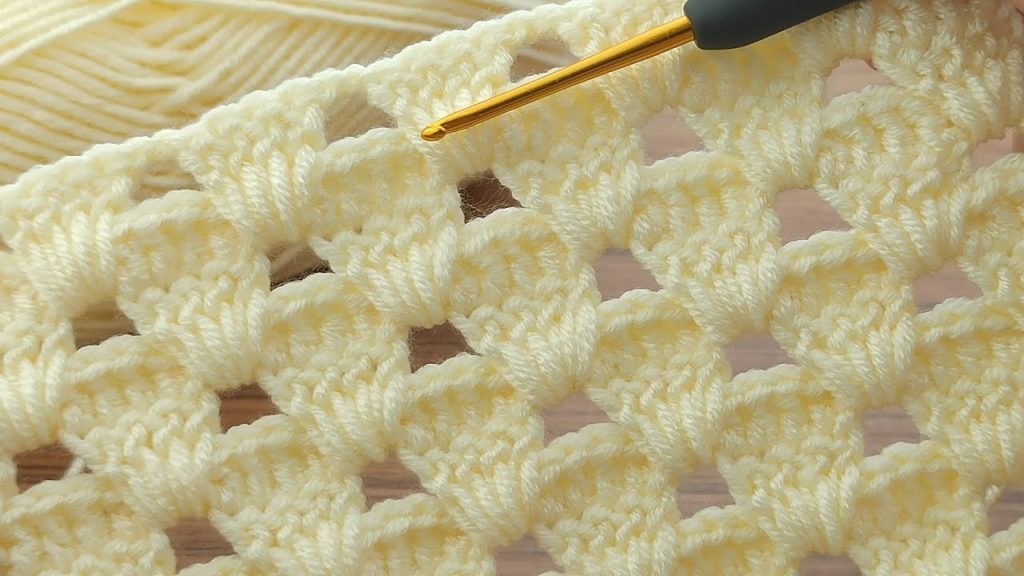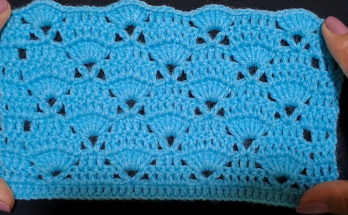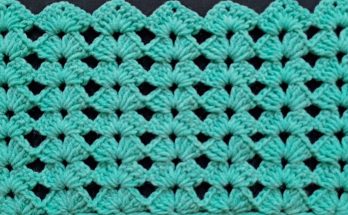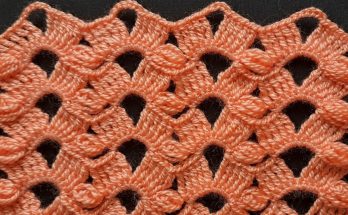
Welcome, lace lovers! Today, we are conquering a stitch that perfectly blends beautiful, defined structure with open, airy lightness. The Defined Shell Grid Stitch (DSGS) creates an interlocking mesh of small clusters that look like repeating hearts or shields, separated by noticeable chain-space windows. The result is a light, elegant fabric that drapes beautifully, making it ideal for shawls, scarves, summer tops, and delicate baby blankets.
The key to this pattern is the two-row repeat that alternates working the structured cluster into the chain spaces, creating the staggered, interlocking grid.

🛍️ Materials, Preparation, and Pro-Level Tips
Choosing Your Tools for Drape
- Yarn Selection: Choose a soft, light-weight yarn such as DK Weight (8-ply) or Sport Weight (5-ply). A fiber with good drape, like a soft acrylic or cotton blend, will let the lace pattern flow beautifully.
- Yarn Note: A single, light color like the cream shown is best for allowing the openwork pattern to be clearly visible.
- Hook Size: Use a 4.0 mm (G-6 US) to 4.5 mm (7 US) hook.
- Critical Detail: Unlike dense textures, you may want to use a hook size exactly as recommended or even slightly larger to ensure the fabric remains light and airy, enhancing the open grid.
- Notions Checklist: Sharp Scissors, a Tapestry Needle, and a measuring tape.
Gauge and Multiple
- Pattern Multiple: This pattern is worked over a multiple of 4 stitches, plus 3 for the foundation chain.
- Example Chain (for a swatch): Ch 27 (4 x 6 = 24, plus 3 = 27).
📌 Stitch Abbreviations & Technical Definitions (US Terms)
Core Stitches
- ch: Chain
- st(s): Stitch(es)
- sc: Single Crochet
- dc: Double Crochet
- sl st: Slip Stitch
- rep: Repeat
- sp: Space
The Key Stitch: The Defined Shell Cluster (DSC)
This cluster of double crochets creates the structured, repeating shape in the grid.
Defined Shell Cluster (DSC) Definition:
(Dc 3) worked into the same designated stitch or space.
➡️ Phase 1: Establishing the Foundation and Base
The foundation creates the initial spaces needed to begin the alternating cluster rows.

Row 1: Foundation Chain & Initial Cluster Setup
- Ch the required number (multiple of 4, plus 3).
- Dc 3 into the 4th ch from the hook (the first 3 skipped chs count as a dc).
- *Ch 1, skip 3 ch.
- Dc 3 into the next ch.*
- Repeat from * to * across the row.
- End with Ch 1, skip 2 ch, dc into the last ch.
- Ch 3 (counts as first dc). Turn.
💖 Phase 2: Creating the Interlocking Grid
This two-row repeat forms the entire beautiful, open texture.

Row 2: Staggered Cluster Pass (Working into the Chain Space)
This row alternates the clusters to create the “windows” and sets up the staggered grid.
- Dc 2 into the first st (which is the top of the last dc from Row 1).
- Ch 1.
- *Dc 3 into the ch-1 space from the previous row. (This creates the shell directly in the opening).
- Ch 1.
- Skip the 3 dc cluster.*
- Repeat from * to * across the row.
- End with a Dc 3 into the last ch-1 space.
- Ch 3 (counts as first dc). Turn.
Row 3: Centered Cluster Pass (Working on Top of the Clusters)
This row centers the clusters above the previous row’s clusters, locking the grid structure.
- Dc 3 into the ch-1 space from the previous row.
- Ch 1.
- *Skip the 3 dc cluster.
- Dc 3 into the ch-1 space from the previous row.*
- Repeat from * to * across the row.
- End with Ch 1, dc into the top of the turning chain (the Ch 3 from the start of Row 2).
- Ch 3 (counts as first dc). Turn.

🔄 Phase 3: The Complete Pattern Repeat
The texture is fully established. To continue the Defined Shell Grid pattern, you will repeat the two core texture rows.
- Next Row: Repeat Row 2 (Staggered Cluster Pass).
- Next Row: Repeat Row 3 (Centered Cluster Pass).
- Full Repeat: Continue repeating Rows 2 and 3 until your piece reaches the desired length.
Stitch Sequence Breakdown:
- Even Rows (2, 4, 6…): Start by working into the first st/edge, then place shells into the ch-1 sps.
- Odd Rows (3, 5, 7…): Place shells into the ch-1 sps, then end by working the last dc into the turning chain.
Video Tutorial:
✂️ Finishing and Structural Integrity
Fabric Characteristics
The finished fabric is light, airy, and features a beautiful drape. The open grid makes it ideal for breathable garments. It is also generally reversible, with the front and back looking nearly identical.
Creating a Polished Edge
- Final Row: End after any Centered Cluster Pass (Row 3). This provides a clean, open edge that matches the start.
- Border: A simple border of Single Crochet (sc) or Slip Stitch (sl st) is sufficient to clean up the sides. If you desire a more decorative edge, a repeating shell border (like sc, ch 3, dc 3 in the same sp) would complement the pattern nicely.
- Blocking: Wet blocking this fabric will significantly open up the lace windows and enhance the drape of the finished item.
Your Defined Shell Grid Stitch fabric is complete—a perfect blend of structure and airy elegance!



